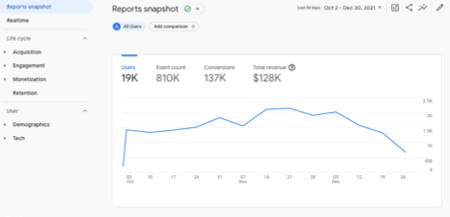In digital marketing, a conversion occurs when a person does what you want them to do and conversion rate optimization is the practice of working to increase the proportion of people who become conversions.

Conversions
A conversion can be anything from filling out a form on a website to making a product purchase. It’s important to define a conversion so it can be easily tracked in analytics. Figure out whether it will be submitting a form buying a product or some other action.
As an example, let’s say you’re running a Google Ads campaign and the objective is to get people to click on your ad, go to a website landing page and submit some information using a form. A conversion would occur every time one of those website visitors person submitted the form. The form submission action can be easily tracked using analytics to determine total number of conversions.
Conversion Rate Optimization (CRO)
Conversion rate is a percentage calculated by dividing conversions by the total number of visitors and conversion rate optimization is the practice of working to increase that percentage by finding ways to get more people to do what you want them to do.
Using the Google Ads example, if 1,000 people click on your ad and end up on your landing page, then 500 of those people take your desired action and submit a form, the conversion rate for that ad campaign would be 50% (500 conversions divided by 1,000 total visitors = 0.5 x 100 = 50%).
How do you improve Conversion Rate?
Improving conversion rate is like investigating a crime scene, you have to search for clues. You have to figure out why more people aren’t doing what you want them to do. Here is a list of some things that can create conversion problems:
- User Interface/User Experience (UI/UX) issue – The page design or content might be confusing people and preventing them from taking action.
- Form issue – The form might be too long or ask questions people aren’t comfortable answering. The form might also have a technical issue where it isn’t formatting correctly on a certain browser (or on mobile)
- Page performance issue – The page might be taking too long to load or the form might not be loading for some users.
- Ad accuracy issue – The Google Ad bringing people to the landing page might not be accurately explaining what you have to offer and people are leaving after they figure it out, not taking the desired conversion action.
These are just some of the reasons conversion rate could be low. The good news is there are a lot of tools available to help digital marketers figure out what problems exist and how to fix them. Conversion rate optimization involves digging through data looking for clues, testing and asking users for feedback.
Experimentation A/B Testing
Experimentation and A/B testing can also uncover ways to improve conversion rate. Sometimes people call A/B testing A/B/X testing, multivariate testing, bucket testing or split testing (there’s always some new term showing up in this industry). They’re all basically the same and can help conversion rate optimization. The objective is to change different characteristics of a landing page or an ad, collect data, analyze the data and figure out which approach provided the best results.
An example of a simple A/B test would be changing the color of calls to action buttons for a group of users to see if blue buttons perform better than green (or vice-versa). Another example could be showing a video on an ad landing page for a group of users to see if it leads to more conversions than another page version that doesn’t contain the video.
If more people convert with a blue button or on a page with a video, then you can use blue buttons and video on your landing page to try to improve conversion rate.
How do I do A/B Testing?
Doing A/B testing used to be a big pain in the ass but now there are applications available that make it easy. The two I uses the most are Optimizely and Google Optimize. These can be easily integrated into a website using JavaScript code snippets and they do all of the hard work. Instead of you having to build new landing pages for testing, these applications can push types of users to different versions of the same landing page (the application manipulates what the user sees). To learn more check out these links:
Some digital marketing tools and CMS applications have built in A/B testing tools. I know the popular Hubspot CRM has built in A/B testing.
With these tools you can manipulate what people see AND collect data without having to build landing pages from scratch and jump back and forth between multiple applications for analytics.
Those are the basics of conversion rate optimization. If you have any questions about it, send them to me here and I’ll get back to you. Thanks for reading and good luck increasing your conversion rate!
-Tom
